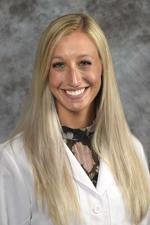About the Program
State-of-the-Art Ambulatory Curriculum
 I chose URMC because I loved the way I felt on the URMC medical campus on my interview day. Everyone was very friendly (and I mean genuinely friendly) and really seemed to care about one another. Also, the faculty is amazing, so smart and always taking the time to teach and provide adequate feedback. All of these qualities (and more) were what I was looking for in a residency program. I wanted a place I would feel comfortable to grow as a physician. It was also important to me that I would be able to have amazing/worthwhile clinical experiences and learn a ton! This is exactly what I found here at URMC!"
I chose URMC because I loved the way I felt on the URMC medical campus on my interview day. Everyone was very friendly (and I mean genuinely friendly) and really seemed to care about one another. Also, the faculty is amazing, so smart and always taking the time to teach and provide adequate feedback. All of these qualities (and more) were what I was looking for in a residency program. I wanted a place I would feel comfortable to grow as a physician. It was also important to me that I would be able to have amazing/worthwhile clinical experiences and learn a ton! This is exactly what I found here at URMC!"
Natalie Penn, MD
Class of 2021
Our “6+2” Block Model allows our residents to focus on their continuity practice, ambulatory electives, and ambulatory education without competing inpatient responsibilities. In a “6+2” block structure there is a 2-week long ambulatory block after every 6 weeks of “usual rotations” throughout residency. Within the ambulatory blocks residents have concentrated ambulatory experiences in their own continuity clinics, in subspecialty clinics, and quality improvement. There is also a dedicated education half day per week in the ambulatory blocks. In contrast, continuity clinics are removed from the “usual rotations,” which allows residents to focus on their inpatient and elective experiences.
Read more about the “6+2” Block Model.
Focus on the Patient
Because we believe residents learn best through direct responsibility in the care of patients, the central educational experience of our residency is the individual patient encounter. Learning occurs through ownership of patients and a balance between progressive responsibility and support.
Our residents:
- Interview and examine patients in a wide variety of clinical settings
- Define each patient's clinical problems and health care needs
- With carefully balanced autonomy and supervision, develop plans for diagnosis and management with their patients
The individual patient is the focus of our rounds and conferences, which often take place at the patient's bedside—a hallmark of a Rochester residency. We create an environment unencumbered by hierarchy, and we promote and expect participation of all learners in an academically rigorous discussion.
Biopsychosocial Model
The University of Rochester is the original home of the biopsychosocial model, which was first described by two faculty members, Drs. Engel and Romano, in 1977. The core tenets of the model continue to be relevant and are integral to the practice of medicine in Rochester.
Residents at the University of Rochester are immersed in clinical practice that considers each patient’s illness within their psychological and social context. Residents’ training emphasizes the care of the whole patient in every setting; specific examples include deliberate teaching about the social determinants of health and communication coaching, and dedicated rotations in palliative care and both outpatient and inpatient geriatrics.
Our Central Educational Goals
The community of residents, staff and our teachers, it was a wonderful and challenging time. I felt supported and listened to in a professional and caring environment."
Class of 2017
- Prepare highly qualified internists who will excel in their chosen career
- Promote compassionate and effective gathering of clinical information from patients and their families
- Instill enthusiasm for lifelong learning
- Teach ways to find, appraise, and apply new scientific knowledge
- Provide early, positive experiences in ambulatory general medicine, inpatient general medicine, subspecialty medicine, and scholarship
- Develop individualized educational plans based on each resident's evolving career objectives
How Our Alumni Feel about Our Program
90%
Would "definitely" choose us again
96%
Were satisfied with their fellowship match
97%
Felt well prepared for their next career steps